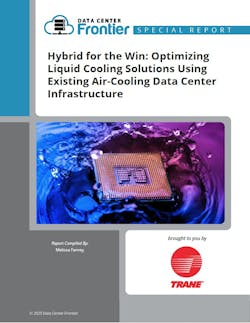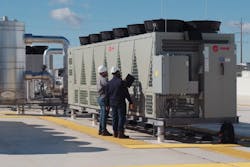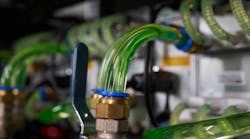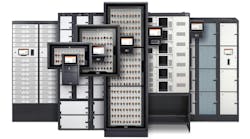Last week we launched our article series on implementing hybrid liquid cooling solutions to navigate the complex interplay of AI, sustainability and operational efficiency. This week, we’ll examine the allure and obstacles of full liquid cooling and why hybrid cooling offers the best of both worlds.
Liquid cooling presents several compelling benefits that address the limitations of traditional air cooling. Its superior heat removal capabilities enable significantly higher rack densities, exceeding 100 kW per rack in advanced deployments, thereby allowing for increased compute power within the same footprint.
By removing heat more efficiently, liquid cooling allows for higher rack densities, translating to more compute power in the same physical space. Liquid cooling also opens up possibilities for eliminating waste in the thermal management system. There is potential for energy reuse and heat recovery which enhance sustainability efforts. For example, the heat captured from liquid-cooled servers can be used to heat nearby buildings or power other industrial processes. This can significantly reduce the overall energy consumption of the data center. However, despite these advantages, the path to full liquid cooling presents new obstacles, causing some data center operators to hesitate before making a complete transition.
The cost of installing liquid cooling systems can be significantly higher than traditional air cooling, particularly in brownfield environments where existing infrastructure needs to be modified. Retrofitting existing data centers can be particularly challenging due to limited space, existing infrastructure constraints, and requirements to maintain uptime. The installation of new piping, pumps, and cooling units can be a complex and time-consuming process.
Concerns about water usage and sustainability also persist. However, closed-loop systems minimize water consumption, and waterless cooling options, such as dielectric fluids, are becoming increasingly available. While closed-loop systems significantly reduce water consumption compared to open-loop systems, they will still require trace water for makeup and evaporation.
Industry organizations like the Open Compute Project (OCP) and ASHRAE are actively working to develop standards and guidelines for liquid cooling, paving the way for more reliable and consistent performance in the future. For example, OCP’s Advanced Cooling Solutions (ACS) project is developing specifications for direct-to-chip liquid cooling systems, while ASHRAE is updating its TC9.9 guidelines to address liquid cooling design and operation. These efforts will help to create a more standardized and reliable market for liquid cooling solutions.
Hybrid Cooling: The Best of Both Worlds
Hybrid cooling, a strategic approach that combines air and liquid cooling solutions, offers a pragmatic way to optimize performance, cost, and sustainability in data centers. By selectively deploying liquid cooling for high-density zones and using existing air-cooled infrastructure for lower-density areas, data center operators can achieve a balance that minimizes disruption and maximizes efficiency, allowing operators to tailor their cooling infrastructure to the specific needs of their workloads.
A hybrid approach provides cost-effectiveness by reducing the need for massive upfront investments. Hybrid cooling allows data centers to leverage their existing investments in air cooling while selectively deploying liquid cooling where it is most needed. Moreover, it offers the flexibility to support diverse workloads, catering to both the high-density demands of AI applications and the more moderate requirements of standard computing tasks. This allows a data center to support a mix of workloads without having to commit to a single cooling technology, leaving options available as designs to support high rack density become more solidified over time. It also allows for a gradual transition to liquid cooling, minimizing disruption to ongoing operations and providing a smoother adoption curve.
The most important benefit of a hybrid approach is that it assists to future-ready data centers for evolving technology demands, providing a scalable and adaptable cooling infrastructure. A key consideration is the potential for overprovisioning due to evolving requirements. Hybridization offers a path forward when facing an uncertain future. In a dynamic environment where workload demands can change rapidly, having a flexible cooling infrastructure is essential.
Brownfield vs. Greenfield: Tailoring Hybrid Cooling Strategies
The approach to implementing hybrid cooling differs significantly between brownfield (existing) and greenfield (new) data centers.
The reality for older air-cooled infrastructures, designed for 15-20 kW/rack, is that they can coexist with liquid- cooled racks at 100 kW, further emphasizing the need for both solutions. A hybrid approach allows data centers to leverage their existing investments in air cooling while selectively deploying liquid cooling where it is most needed. This can significantly reduce the cost and disruption associated with upgrading a data center’s cooling infrastructure
Benefits of Greenfield Data Centers: New data centers offer greater design flexibility and the opportunity to optimize cooling infrastructure from the ground up. In a new data center, operators have the freedom to design the cooling infrastructure from scratch, taking into account the latest technologies and best practices. In greenfield environments, hybrid cooling solutions can be strategically implemented from the outset, with liquid cooling dedicated to high-density zones and air cooling used for lower-density areas. This allows for a more efficient and cost-effective cooling system overall. For example, a data center could be designed with a dedicated liquid-cooled zone for high-performance computing and a separate air-cooled zone for general- purpose servers. This allows for a more efficient and cost-effective use of cooling resources.
Trane® provides insights on how hybrid cooling solutions can reduce heat rejection in greenfield projects and optimize data center design. Their engineered system control solution seamlessly integrates with equipment, leveraging the control capabilities that are already part of the unit, allowing for easy system configuration and customization to meet the unique needs of each facility. Key design shifts include moving cooling distribution to areas outside the white space and using water-cooled chillers indoors. Changes like these require careful planning and coordination to ensure that the cooling system is integrated seamlessly with the overall data center infrastructure. For example, moving cooling distribution to grey spaces can free up valuable white space and allow for more efficient cooling of high- density zones. Using water-cooled chillers, which are installed indoors, can improve energy efficiency and reduce noise pollution.
Download the full report, Hybrid for the Win: Optimizing Liquid Cooling Solutions Using Existing Air-Cooled Data Center Infrastructure, featuring Trane, to learn more. In our next article, we'll explore how sustainability and energy efficiency give hybrid cooling systems a competitive edge.





